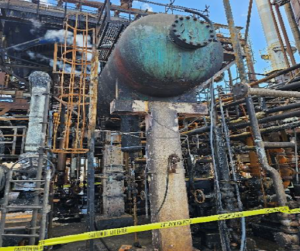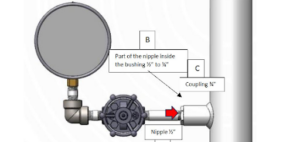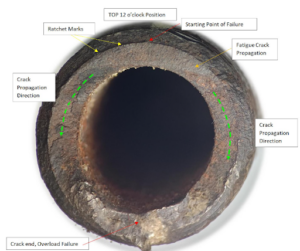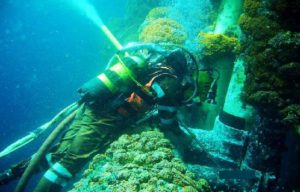
INTRODUCTION:
Subsea pipelines or submarine pipelines are those usually laydown on seabed or inside of a trench below sea. Due to the marine conditions (sea roughness, alkaline conditions) and the self-contents, pipelines are usually under high risk of corrosion and erosion damage mechanisms apart from mechanical loading or stressing. Offshore steel pipelines are normally designed for a life ranging from 10 years to 40 years. To enable the pipeline to last for the design life, the pipeline needs to be protected from corrosion both internally and externally.

Protection of the pipelines also involves sacrificial anode installations at defined lengths depending on the risk rating. However, anti-corrosion coatings play a vital role in keeping the pipelines yielding designed life time. Fusion bonded epoxy coatings were found to be effective solution to keep the pipeline safe from corrosion and reinforced concrete is applied on top of it to for additional protection & give weight to help the pipeline remain laterally stable on the seabed, or for providing insulation. The other coatings that can be used with concrete coating are coal tar enamel and coal tar epoxy and they are used with lower product temperatures. Both of these coatings are bituminous coatings reinforced with fiberglass. However, most bituminous coatings are not desirable due to environmental laws and decreasing efficiency (sagging, cracking, permeation, and chemical deterioration).
INTEGRITY CONCERNS & STRATEGY:
Monitoring at regular intervals of marine pipeline against corrosion or erosion damage mechanisms is an important strategy to maintain its integrity. Unlike above ground equipment or piping, subsea sections of pipeline have limitations to carry out external inspections using conventional methods due to the existence of applied coatings and marine growth. Even though in-line inspections using Pigs can be performed from internal side, the requirement to inspect some section of pipeline which has high risk rating or the restrictions to apply in-line inspections due to pipeline geometry, operational conditions set forth limitations to adopt this technology in some cases.
Some of the guidelines on the in-service inspection of subsea pipelines recommends to develop an inspection strategy considering risk rating, conditions of the pipeline, contents, weather conditions.
The phases of in-service inspection include operation preparation, inspection, survey, maintenance and repair. During the operation condition, in-service inspections and surveys are to be conducted for pipelines. In-service inspections and surveys are to be planned to identify the actual conditions of pipelines for the purpose of integrity assessment. Typically, In-service inspection can be planned based on the following:
- At each Annual Survey, the records of maintenance are to be reviewed for compliance with the approved maintenance plan. The function of the safety protective devices is to be proven in order.
- Any subsea maintenance inspection carried out internally or externally of the pipeline is to be verified and reported. At each five (5) year interval, the complete maintenance records are to be reviewed.CURRENT INSPECTION SCOPE:
TechCorr carried out in-service inspection of the for assessment of corrosion under coating of Subsea Pipeline Ending Manifold (PLEM) using Pulsed Eddy Current Testing Technique (PECT) in one of the offshore facilities in India. PECT was used for above application as it is difficult to get Ultrasonic thickness readings of base metal without removal of insulation. PECT technique can provide average remaining wall thickness within footprint area & extent of the corrosion/erosion of base metal. Proper safety arrangements permit and on-site support was offered and fulfilled by Client Team. Co-operation offered by Divers/ROV team to inspection engineers of TechCorr made the completion of job easier during field survey.
THE TECHNIQUE:
Pulsed eddy current (PEC) technology uses electromagnetic induction to inspect corrosion of ferromagnetic material without the need to make contact with the material’s surface.
Because PEC equipment does not need to make surface contact with the components under inspection, it is ideal for components that are:
- covered by insulation, asbestos, fireproofing, or concrete
- coated with materials like bitumen, polyethylene, or epoxy
- partially or fully submerged in water
- covered in corrosive material, such as rust
- used in high temperature applications
- used to house or transport hazardous material and therefore cannot risk damage that may occur if surface were scoured for testing.
-
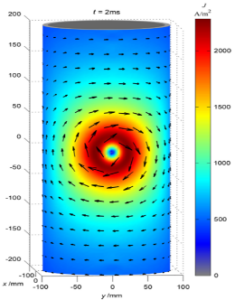
PENETRATING SCANS:
PEC can produce wall thickness measurement with ±10% accuracy through:
- 10” (250mm) of obscuring insulation or fireproofing
- .75” (20mm) of marine growth, coatings, and corrosion.
APPLICATIONS:
Typical applications include inspections of:
|
|
METHODOLOGY:
TechCorr used latest Pulsed Eddy Current Technology to perform corrosion screening on submerged pipeline end manifolds (PLEM) (typical scan plan and drawings have been presented below). With the help of diver, TechCorr operator collected PECT readings in predefined locations of the PLEM system across the cross section and linear locations without removing the marine growth or coating. Successful inspection has been carried out on these sections within the short time which has resulted in high cost saving and achieving integrity management requirements.
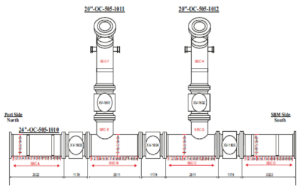
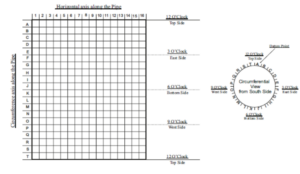
RESULTS AND FINDINGS:
Testing has revealed minor wall loss (with an average remaining wall thickness percentage of 89% under foot print area) has been recorded on one of the sections. No major findings were recorded under the current scope of inspection. A snapshot of the PECT measurements on the one of the sections scanned has been presented below providing overview of the color coded PECT measurements with remaining wall thickness measurements.
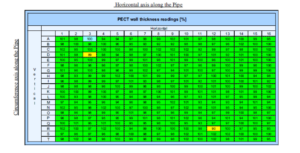
CONCLUSION: Pulsed Eddy Current Testing is proved to be an effective tool to screen the submerged pipelines without removing the coatings making the non-piggable, piggable pipeline sections for quick assessment on the pipeline condition and in meeting the integrity management requirements to detect any unforeseen severe corrosion damage to the pipeline at early stages when monitored at regular intervals.



 Customized Repair Strategy and Structural Integrity
Customized Repair Strategy and Structural Integrity
